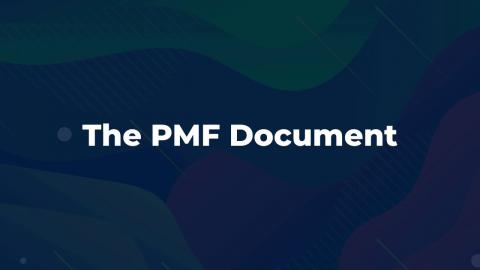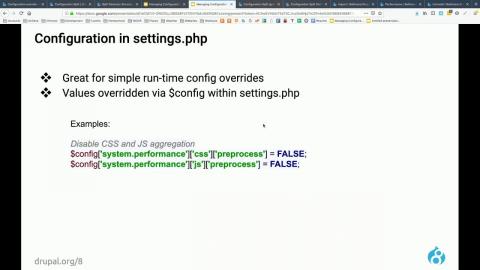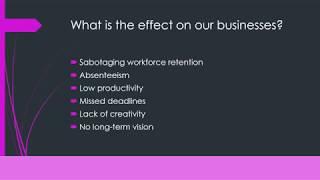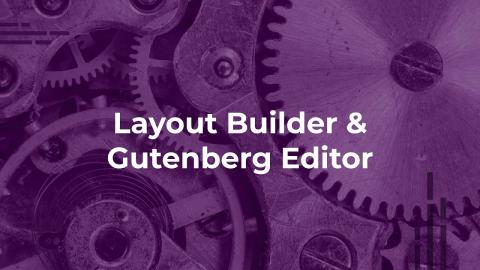Introduction
The 2019 Baltimore DrupalCamp took place on Friday, September 27, at the Creative Alliance at the Patterson, a really cool art/culture space in the Highlandtown Arts District. No matter your experience with Drupal, Baltimore DrupalCamp will have opportunities for you to learn and engage with others. Come join the Drupal open source community, meet talented people from around the Mid-Atlantic region, and sharpen your web design and development skills.
Video Sponsor(s) / Provided by
Curated Videos
Description
Use a Performance Measurement Framework to inform priorities and growth!
You will likely get many different answers if you asked any one person on a development team, designers, subject matter experts, or key stakeholders: "How do we measure the success of this project?" That can be a problem because people are working from too many directions to be considered a team effort.
We will fix that in this presentation by reviewing the strategy to create a "Performance Measurement Framework" for everyone to rally behind. This is a living thing that can change, while aligning everyone under common Key Performance Indicators (KPIs) and holding people responsible for their hypotheses they recommend to improve those measurements. This work is heavily inspired by The Lean Startup, Agile development practices, and growth-driven design.
The slides for this presentation are here: http://bit.ly/ut-performance-measurement-framework
You can see an example of me presenting on a different topic here: https://vimeo.com/348632395
You will likely get many different answers if you asked any one person on a development team, designers, subject matter experts, or key stakeholders: "How do we measure the success of this project?" That can be a problem because people are working from too many directions to be considered a team effort.
We will fix that in this presentation by reviewing the strategy to create a "Performance Measurement Framework" for everyone to rally behind. This is a living thing that can change, while aligning everyone under common Key Performance Indicators (KPIs) and holding people responsible for their hypotheses they recommend to improve those measurements. This work is heavily inspired by The Lean Startup, Agile development practices, and growth-driven design.
The slides for this presentation are here: http://bit.ly/ut-performance-measurement-framework
You can see an example of me presenting on a different topic here: https://vimeo.com/348632395
Description
In 2017 the second Drupal Business Survey was released with good news for businesses offering Drupal services. Drupal is growing steadily and Drupal 8 has a strong place in the market. But the survey also points to some trends that Drupal shops need to be aware of. For example the survey had this to say:
The evolution of the CMS marketplace to favor more comprehensive and thus also more complex solutions is favoring bigger companies with stronger competences through number of experts in specific fields. This can be a struggle for small vendors, as mastering clients’ needs requires more expertise than is available on their staff.
If the trend is truly towards larger businesses building enterprise level projects, how will smaller Drupal agencies survive? This session will discuss how the release of Drupal 8 and trends in the marketplace affect smaller Drupal agencies. We’ll look at how the release of Drupal 8 has changed our target market, and propose ways for smaller Drupal shops to thrive in this new environment.
How big is big?
What do we mean when we talk about larger businesses? How big is a large Drupal agency? What do we consider as small. According to the Bureau of Labor statistics 90% of companies are under 20 employees. There are only a few large Drupal service providers with over 500 employees. And while there are many Drupal agencies with over 20 employees, most businesses providing Drupal services are closer to 12 employees with the majority being microshops with 2 or 3 employees. Let’s look at agency sizes and how size may relate to competitiveness.
Enterprise Drupal
Yes the sophistication of Drupal 8 is more suited for larger projects and great for the enterprise. Let’s parse out what types of projects are more suitable, and where smaller Drupal shops can provide value. We'll look at some lessons learned from past experiences in the enterprise market, and make some connections with Drupal's enterprise aspirations.
Higher Level of Entry
There’s a lot of talk going round about Drupal 8 demanding more technical expertise. Let's take a close look at the skills required to provide solutions with Drupal 8. What do these changes mean to site builders. What might smaller agencies do to survive the move to Drupal 8.
Drupal People
What do these trends mean for the Drupal community? This session will take a look at how trends might affect the Drupal community, contributions, and the Drupal labor pool. What are larger firms doing? What can smaller agencies learn from them.
The evolution of the CMS marketplace to favor more comprehensive and thus also more complex solutions is favoring bigger companies with stronger competences through number of experts in specific fields. This can be a struggle for small vendors, as mastering clients’ needs requires more expertise than is available on their staff.
If the trend is truly towards larger businesses building enterprise level projects, how will smaller Drupal agencies survive? This session will discuss how the release of Drupal 8 and trends in the marketplace affect smaller Drupal agencies. We’ll look at how the release of Drupal 8 has changed our target market, and propose ways for smaller Drupal shops to thrive in this new environment.
How big is big?
What do we mean when we talk about larger businesses? How big is a large Drupal agency? What do we consider as small. According to the Bureau of Labor statistics 90% of companies are under 20 employees. There are only a few large Drupal service providers with over 500 employees. And while there are many Drupal agencies with over 20 employees, most businesses providing Drupal services are closer to 12 employees with the majority being microshops with 2 or 3 employees. Let’s look at agency sizes and how size may relate to competitiveness.
Enterprise Drupal
Yes the sophistication of Drupal 8 is more suited for larger projects and great for the enterprise. Let’s parse out what types of projects are more suitable, and where smaller Drupal shops can provide value. We'll look at some lessons learned from past experiences in the enterprise market, and make some connections with Drupal's enterprise aspirations.
Higher Level of Entry
There’s a lot of talk going round about Drupal 8 demanding more technical expertise. Let's take a close look at the skills required to provide solutions with Drupal 8. What do these changes mean to site builders. What might smaller agencies do to survive the move to Drupal 8.
Drupal People
What do these trends mean for the Drupal community? This session will take a look at how trends might affect the Drupal community, contributions, and the Drupal labor pool. What are larger firms doing? What can smaller agencies learn from them.
Description
Ideally, organizational and project alignment is brought into focus during the discovery phase. Oftentimes, this isn’t the case, and can be especially apparent in existing projects facing challenges. Perhaps because of ingrained organizational practices—and differences between internal team cultures, there can appear to be insurmountable gulfs, leaving people to wonder where to start. Ideally, a comprehensive revamp would be in order—but this option is often off-the-table.
This is where we UX practitioners come in. Aside from solid user research and internal evangelizing—like any major cultural change—a ground-up approach is often required. Here, user needs (and a gradual strategic revamp) are put forth in day-to-day processes focused on the larger goal.
In this presentation, attendees will learn how to:
- Build rapport with team members—and effecting horizontal understanding and buy in through shared understanding.
- Introduce concepts of user experience to non-practitioners on your team by making them part of the process.
- Make impact early by focusing on small wins tied to the larger picture.
- Use these gains to build a culture of learning and growth to help users (the real stakeholders)—which helps your organization.
This presentation is geared toward user experience practitioners of all skill and experience levels, who are (or anticipating) systemic project challenges, and are wanting to improve their product and organization through incremental and lasting change.
This is where we UX practitioners come in. Aside from solid user research and internal evangelizing—like any major cultural change—a ground-up approach is often required. Here, user needs (and a gradual strategic revamp) are put forth in day-to-day processes focused on the larger goal.
In this presentation, attendees will learn how to:
- Build rapport with team members—and effecting horizontal understanding and buy in through shared understanding.
- Introduce concepts of user experience to non-practitioners on your team by making them part of the process.
- Make impact early by focusing on small wins tied to the larger picture.
- Use these gains to build a culture of learning and growth to help users (the real stakeholders)—which helps your organization.
This presentation is geared toward user experience practitioners of all skill and experience levels, who are (or anticipating) systemic project challenges, and are wanting to improve their product and organization through incremental and lasting change.
Description
In a user-first world, content is the basis for ensuring great user experience. A content audit lays the groundwork for aligning organizational objectives with site visitor needs. It is the preparatory work for the site architecture, content model, and page layouts. It addresses content governance and the content creation process.
Additionally, a content audit can be a tool for building collaboration, credibility, and respect for the role of the content strategist on the web team. We can embrace and agree upon values, goals, and realities that set the stage early in the project for ongoing cooperation.
This session will provide content strategists both the understanding of how to conduct a content audit, as well as the insights for making the content audit a key tool for website collaboration.
You will learn how to:
Conduct the quantitative and qualitative aspects of the content audit.
Tie the audit to the needs of content creators for creating sustainable content.
Collaborate with all team members, with a fresh understanding of where content fits into a web project.
Build credibility within the organization for the practice of content strategy.
Additionally, a content audit can be a tool for building collaboration, credibility, and respect for the role of the content strategist on the web team. We can embrace and agree upon values, goals, and realities that set the stage early in the project for ongoing cooperation.
This session will provide content strategists both the understanding of how to conduct a content audit, as well as the insights for making the content audit a key tool for website collaboration.
You will learn how to:
Conduct the quantitative and qualitative aspects of the content audit.
Tie the audit to the needs of content creators for creating sustainable content.
Collaborate with all team members, with a fresh understanding of where content fits into a web project.
Build credibility within the organization for the practice of content strategy.
Description
Write for a better reading experience!
We all know how to write, but do you know how to write effectively for your target audience? Have you considered their experience, your professional tone, or what impact you are trying to have? Do you want to save time and work well with others on a writing effort? In this presentation we will review a strategy to improve your professional writing so your message is received clearly.
The slides for this presentation are here: http://bit.ly/ut-professional-writing
You can see an example of me presenting on a different topic here: https://vimeo.com/348632395
We all know how to write, but do you know how to write effectively for your target audience? Have you considered their experience, your professional tone, or what impact you are trying to have? Do you want to save time and work well with others on a writing effort? In this presentation we will review a strategy to improve your professional writing so your message is received clearly.
The slides for this presentation are here: http://bit.ly/ut-professional-writing
You can see an example of me presenting on a different topic here: https://vimeo.com/348632395
Description
In Drupal 8, settings and configurations are stored in code using configuration management. We do this by importing and exporting the whole set of the sites configuration. But a lot of times you want different configurations in other environments. There are many ways this can be managed. In this session, we will discuss configuration management and how it can be overridden by using modules such as config_split, config_ignore. We will also discuss how the settings.php file can override configuration and when this should be used. This session will also cover the importance of overrides if different environments.
Description
“The medium, or process, of our time—electric technology—is reshaping and restructuring patterns of social interdependence and every aspect of our personal life. It is forcing us to reconsider and reevaluate practically every thought, every action, and every institution formerly taken for granted.”
— Marshall McLuhan
When Marshall McLuhan wrote these words in 1967 television was the medium transforming communication. From our perspective, after fifty years of technological innovations, “The Medium is the Massage” remains thought provoking. Today, how and what we communicate has been altered in ways we rarely stop to notice. As the people who “make the Internet” let’s pause to take a look at the language of the web, inventory the current tool set, and analyze of the web’s most effective communicators.
A lot has changed since the first website went live on August 6, 1991. Though video and animation flourish within the medium the web’s primary mean of communication remains the written word. How well are we leveraging the web as a publishing platform. Are we truly writing for the web, are we leveraging the medium? How can we become better at speaking the language of the web? We’ll take a look at some examples of writers and publishers effectively leveraging the web’s language.
Though talk of 3D and VR often draws attention, what are the current communication tools of choice? As the people who design and build web publishing outlets what tools are we equipping content creators with? How well are content creators and technologists collaborating in creating effective messages for web audiences.
As programmers and designers what can we do to elevate communication?
Drupal was born as a collaboration platform. Then became a publishing platform that’s become a communication toolbox. What can we do to ellevate communication using Drupal.
Objectives
Inspire how we think about the web by looking at thought provoking writers and designers.
Look at examples where communication has been elevated by the medium of the web.
Explore how Drupal can be used to leverage the language of the web.
Audience
Designers and people who make the Internet
Publishers
Content creators
— Marshall McLuhan
When Marshall McLuhan wrote these words in 1967 television was the medium transforming communication. From our perspective, after fifty years of technological innovations, “The Medium is the Massage” remains thought provoking. Today, how and what we communicate has been altered in ways we rarely stop to notice. As the people who “make the Internet” let’s pause to take a look at the language of the web, inventory the current tool set, and analyze of the web’s most effective communicators.
A lot has changed since the first website went live on August 6, 1991. Though video and animation flourish within the medium the web’s primary mean of communication remains the written word. How well are we leveraging the web as a publishing platform. Are we truly writing for the web, are we leveraging the medium? How can we become better at speaking the language of the web? We’ll take a look at some examples of writers and publishers effectively leveraging the web’s language.
Though talk of 3D and VR often draws attention, what are the current communication tools of choice? As the people who design and build web publishing outlets what tools are we equipping content creators with? How well are content creators and technologists collaborating in creating effective messages for web audiences.
As programmers and designers what can we do to elevate communication?
Drupal was born as a collaboration platform. Then became a publishing platform that’s become a communication toolbox. What can we do to ellevate communication using Drupal.
Objectives
Inspire how we think about the web by looking at thought provoking writers and designers.
Look at examples where communication has been elevated by the medium of the web.
Explore how Drupal can be used to leverage the language of the web.
Audience
Designers and people who make the Internet
Publishers
Content creators
Description
Test Everywhere: A Journey into DevOps and Continuous Testing
A move to DevOps creates an opportunity to shift the testing process to the left. But what if you went further? DevOps supports continuous testing, so you can advocate for a constant focus on quality, with testing permeating the entire software development process. Here's how you can actually have a faster testing process when the software is tested throughout the lifecycle, by developers, testers, and automation alike. It’s a constant challenge to remove the concept that testing is a financial drain and time bottleneck that is a threat to product delivery. My counterargument has always been that post-release bug fixes from poorly tested (or even untested) software are more expensive and damaging to the company reputation, and properly planned and executed testing processes do not cause delays or excess costs.
My goal was to have testing and development work in parallel and act in conjunction for their mutual benefit. Instead of the usual practice of banging out the code for a list of features for every sprint, a prioritized list of features is recorded in descending order in a TESTME.md file, a short, markdown-language file that uses the Gherkin syntax. This list focuses both the developer and tester on the simultaneous coding and test creation for each feature by importance. Following the creation and execution of unit tests, the TESTME.md-based tests are then created and executed using Behat, and is followed by Functional test sets. The purpose of this approach is to create and execute tests during each stage of development as part of the Development process.
A move to DevOps creates an opportunity to shift the testing process to the left. But what if you went further? DevOps supports continuous testing, so you can advocate for a constant focus on quality, with testing permeating the entire software development process. Here's how you can actually have a faster testing process when the software is tested throughout the lifecycle, by developers, testers, and automation alike. It’s a constant challenge to remove the concept that testing is a financial drain and time bottleneck that is a threat to product delivery. My counterargument has always been that post-release bug fixes from poorly tested (or even untested) software are more expensive and damaging to the company reputation, and properly planned and executed testing processes do not cause delays or excess costs.
My goal was to have testing and development work in parallel and act in conjunction for their mutual benefit. Instead of the usual practice of banging out the code for a list of features for every sprint, a prioritized list of features is recorded in descending order in a TESTME.md file, a short, markdown-language file that uses the Gherkin syntax. This list focuses both the developer and tester on the simultaneous coding and test creation for each feature by importance. Following the creation and execution of unit tests, the TESTME.md-based tests are then created and executed using Behat, and is followed by Functional test sets. The purpose of this approach is to create and execute tests during each stage of development as part of the Development process.
Description
We are told that we need to take a vacation, buy something nice, or achieve work/life balance. But those actions do not get to the source of burnout. Within days, stress returns as fierce as ever. Without addressing the causes of habitual stress, we will never experience the wholeness of our lives.
A majority of US adults suffer from on-the-job burnout. This leads to serious physical and psychological illness, low productivity, declining motivation, rising turnover rates, and increasing healthcare costs.
The growing public health crisis that is stress can be understood from a scientific perspective. Join a trained mindfulness teacher, with a many decades long IT career, as we address how organizations can tap into their ability to adjust organizational culture to care for those for whom we are responsible. We will discuss the concept of mindfulness, and how it works to reduce stress, leaving us empowered, productive, and fulfilled.
A majority of US adults suffer from on-the-job burnout. This leads to serious physical and psychological illness, low productivity, declining motivation, rising turnover rates, and increasing healthcare costs.
The growing public health crisis that is stress can be understood from a scientific perspective. Join a trained mindfulness teacher, with a many decades long IT career, as we address how organizations can tap into their ability to adjust organizational culture to care for those for whom we are responsible. We will discuss the concept of mindfulness, and how it works to reduce stress, leaving us empowered, productive, and fulfilled.
Description
In Drupal 8, site building as it relates to page layouts has become an increasingly complex issue. Between Paragraphs, Blocks, Panels, Layout Builder, and Gutenber Editor, the choices are seemingly endless for creating a solution that works for both developers and content editors.
We all know about Blocks, Paragraphs, and Panels—they are nothing new on the scene.
In this session, I will shine some light on two relatively new methods for site building and why I believe they are the future of Drupal page layouts. We will demo both the Gutenberg editor as well as the new Layout Builder, to display their strengths, weaknesses, and overall impact on site builders and content editors. These two new editors have the potential to change the way we design and build sites, and should be strongly considered as the new contender against Paragraphs and Panels.
Additionally, here is a recent blog post I created on layout builder, which I will be using to inform that portion of my talk: https://www.unleashed-technologies.com/layout-builder-in-drupal-8.
We all know about Blocks, Paragraphs, and Panels—they are nothing new on the scene.
In this session, I will shine some light on two relatively new methods for site building and why I believe they are the future of Drupal page layouts. We will demo both the Gutenberg editor as well as the new Layout Builder, to display their strengths, weaknesses, and overall impact on site builders and content editors. These two new editors have the potential to change the way we design and build sites, and should be strongly considered as the new contender against Paragraphs and Panels.
Additionally, here is a recent blog post I created on layout builder, which I will be using to inform that portion of my talk: https://www.unleashed-technologies.com/layout-builder-in-drupal-8.
Description
Team London is the Mayor of London's volunteering programme, encouraging all Londoners to become active citizens and to give their time to make the UK's capital city a better place.
Working with the Greater London Authority, Zoocha undertook a project to reinvent the Team London digital experience, bring together volunteers and good causes to connect online.
From user research to launch, this case study demonstrates how Drupal is used to connect citizens in one of the Worlds greatest and most diverse cities.
Key Take Outs
At this session, you'll hear about how we:
Started with the user
Worked as an agile team
Coded in the open
Working with the Greater London Authority, Zoocha undertook a project to reinvent the Team London digital experience, bring together volunteers and good causes to connect online.
From user research to launch, this case study demonstrates how Drupal is used to connect citizens in one of the Worlds greatest and most diverse cities.
Key Take Outs
At this session, you'll hear about how we:
Started with the user
Worked as an agile team
Coded in the open










